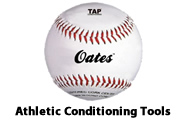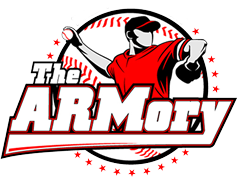The Connection Ball: A Case Study
I’d like you to meet Ryan Kopenski.
He gave me permission to tell his story.
Ryan is a sophomore left handed pitcher at Central Florida Community College. His most recent season didn’t go as well as he would have liked. He spent the entire spring season hovering at 80-81 mph and fighting constant pain in his medial elbow that he rated at a level of 5 out of 10.
When he came to The ARMory for his initial evaluation on June 18th, 2014 his elbow was still hurting every time he threw.
His physical assessment revealed significant opportunities for improvement in: scapular dyskinesia,GIRD (Shoulder internal rotation deficit), and thoracic mobility. His Modified Thomas Test showed tight hip flexors on both sides, and he had hip internal rotation deficits on both sides.
He scored reasonably well on his functional movement screen.
The shoulder range of motion test, active straight leg raise, and rotational core stability were his only deficits.
During his video analysis we noticed that he did not activate his glutes well, his lead leg disconnected early, his torso rotated before his front foot hit the ground, and when he was weight bearing on his front foot, the angle between his humerus and forearm exceeded 90 degrees (forearm flyout).
I know still pictures don’t tell the entire story, but here is a screen shot from his initial eval.
The angle between his humerus and forearm is approximately 98 degrees.
After releasing the ball, he failed to internally rotate his shoulder and pronate his forearm. He finished in a fielders’ position, did not continue rotating around his front hip, and his elbow crossed the midline of his body causing a late bang on his posterior shoulder.
All of the aforementioned physical, functional, and mechanical inefficiencies have been found to be possible contributors to medial elbow pain, so I knew we had some work to do.
Ryan purchased a copy of Engineering The Superhuman Pitching Volume 3:Taking Action, Targeting Your Training and got to work on correcting his mechanical constraints. SH3 is written in the exact same format as our evaluation form with each line on the evaluation representing a chapter in the book containing 3-6 corrective drills and exercises. Verbal descriptions, sequential still photos, and video clearly describe the technique and nuances of every activity.
Ryan also began training at The ARMory 2-3 times per week to build a pitcher specific power motor using our Superhuman Fab 4 workouts described in SH Volume 1. During the throwing portion of his individualized training sessions, he started performing the appropriate drills to eliminate his mechanical inefficiencies.
Our main challenge was deciding which mechanical variables to address first.
According to a 2009 Study commissioned by major leagu
As early as 1986 Dr James Andrews and colleagues told us that “any force that shifts the humeral head to the rim of the glenoid fossa….will cause the humeral head to be reseated off center, placing the labrum in jeopardy for injury.”
Patterns such as crossing the acromial line, the infamous inverted W, and the elevated distal humerus clearly move the head of the humerus from its packed, centralized position and put the labrum under duress.
Check out this figure from a 2008 article in the Journal of Sport Science and Medicine.
(Myashita et al, Journal of Sports Science and Medicine (2008) 7, 47-53
Relationship between maximum shoulder external rotation angle during throwing and physical variables)
Now look at the guy in the middle (that’s and inverted W), and the guy on the right (crossing acromial line). Those two patterns were identified as increasing the risk of shoulder and/or elbow injuries.
Failure to internally rotate and pronate into launch has also been shown to be a significant contributor to medial elbow pain. According to a 1999 study in
So the evidence is clear. Certain arm action and deceleration patterns, like the the ones shown above, can put pitchers at greater risk for injury.
In the absence of pain, it may be ok to ignore those issues, but at the first sign of pain, we must intervene and correct if we want to progress safely. Even then, there is no guarantee. All we can do is identify all the known variables that might put a pitcher at risk and then try to suppress them with our training so we can intricately thread the needle between ability development health and durability.
Now back to Ryan
Recall that upon evaluation, Ryan had both early torso rotation and forearm flyout. Either or both of these issues could be contributing to his elbow pain. But Ryan also had a lead leg disconnect and poor glute activation, both of which could be culprits as well.
The truth is, his elbow pain was probably the result of a combination of all his physical, functional, and mechanical constraints.
The questions we needed to answer were, “Where do we start?” and “How do we prioritize his problems to create an individualized training plan that gives him the best chance for success?”
Sometimes, in the absence of pain, you can eliminate arm action issues by improving a pitchers ability to utilize his lower half. More efficient use of his glutes and better control of his center of mass can sync up the arm action and you can solve all of his issues without ever addressing his arm action.
However, Ryan was complaining of significant medial elbow pain, which was severely limiting his ability to throw, so the first thing we needed to do was get him pain free. I was worried that if we added energy to the system by working on his lower half before he was pain free, then we would be risking further damage to the soft tissue in his elbow, leading him down a path that ultimately ended in Tommy John surgery.
What did we do?
We took some advice from my friend and mentor Ron Wolforth and started with the pain.
We decided to attack the forearm flyout first.
Once this was clean, we could add extensive work on glute activation, throw in a healthy dose of primal intent, and let his body figure out where to go from there.
We introduced him to the Coach Wolforth’s brilliant idea, the connection ball—a nearly weightless textured rubber ball that would teach him to feel what it meant for his elbow to be inside of 90 degrees at weight bearing foot plant as described by Aguinaldo and Chambers.
Here is a picture of Ryan training with a connection ball. Notice how he trains to feel his arm well within th 90 degree threshold.
The ball doesn’t stay in this position. It launches forward with his throwing motion, giving him immediate feedback if his forearm flies out.
For a while,Ryan struggled to get the connection ball to launch toward the target or to his glove side, but even while struggling, you could see a later, safer launch beginning to emerge.
We also prescribed the drills coach Wolforth laid out in his “Solve Your Disconnection” DVD series.
Ryan performed the throwing protocol for 21 days straight, using the connection ball for nearly all the throws for the first five days, then gradually weaning himself from it as his “feel” for a safer, more efficient movement pattern began to improve.
After 21 days, we shot another video and compared it to his initial evaluation.
Here it is:

The forearm flyout had disappeared!
His elbow angle at weight bearing foot plant was at a much safer 78 degrees.
More importantly, the pain in his elbow was gone!
At this point we put the radar gun on him for the first time since his initial evaluation, and it read 84.3 mph.
He had gained 4.3 mph by eliminating his painful forearm flyout.
Now we could begin to address the lower half problems and he would be on his way!
There are folks out there in cyberspace blasting the use of connection balls, claiming that they are “devastating pitchers’ arm action”.
One recent blogger indicted the connection ball as a “One-Size fits all approach” that “Betty Crockers…EVERY SINGLE pitcher”.
I get it.
A common internet marketing practice is to generate controversy to increase sales.Vitriolic criticism of the ideas of others creates buzz.
Not my style, but to each his own.
Everyone is entitled to his own opinion, but you can’t invent or deny the facts.
I’d like to ask you a few questions.
When you read the previous several paragraphs, did it become obvious how thorough and meticulous our assessment process is?
Did it become clear that items we evaluate are are not just conjecture, but are based on in-depth and painstaking research?
The process we use to evaluate each pitcher is evolving and changing every day. We currently check for 32 physical constraints and 28 mechanical variables–nearly all of which have been shown in peer-reviewed research (either directly or by inference) to decrease performance and to increase risk of injury. In Superhuman Vol 2, we lay out in clear, easy to understand terms, a stepwise guide for Conducting a World Class Pitcher Assessment.
Do you believe that represents a cookie cutter approach?
I say it all the time……
You cannot cookie cut this stuff.
It’s way to complex.
But you must have a system for evaluating and treating inefficiencies known to increase the risk of injury and decrease performance.
Otherwise, you’re just shooting in the dark and hoping you hit something.
We check each pitcher for every risky variable we currently know of.
Then we develop an individualized training plan specifically designed to carve those constraints away.
As our research reveals other emerging factors, we will add them to our assessment, and we’ll develop innovative strategies to eliminate them.
Scores of researchers have identified many of the variables that could put a pitcher at risk.The information is there if you’re willing to look for it.
The cool thing about what I’m finding is that the same variables that help a pitcher throw harder also improve his command and put him at less risk for injury.
In pitching, performance enhancement and safety can be achieved concurrently, using the same training methods for each!
If Ryan Kopenski’s evaluation results had turned out differently, his training plan would have taken us down and entirely different path. If he hadn’t been complaining of pain, and if he hadn’t demonstrated dangerous arm action tendencies, he would have never touched a connection ball.
In our program, individual styles are accepted and encouraged.
But there are known parameters of safety within which every pitcher’s movement patterns should fall. Inside those boundaries, there are LOTS of degrees of freedom for individual expression and performance.
One size certainly does not fit all.
In fact, one size does not fit one for very long.
I urge you to take a look at the mechanics of our most accomplished pitcher to date, Chicago White Sox 2013 Second round draft pick, Tyler Danish. His unique, quirky motion was created entirely by him. My only role was to make sure it was within the limits of safety. After that, I simply provided objective feedback, got out of the way, and let his body figure what worked best for him.
That’s exactly how we treat every pitcher who trains at The ARMory.
I have read in a few blogs that arm action is “a learned skill that is ingrained into the nervous system.”
I agree.
In fact, I would say that every movement pattern from brushing your teeth to scratching your rear end is “a learned skill that is ingrained into the nervous system.”
But the implication that arm action and other movement patterns, once learned, are set in stone and cannot be changed when necessary, is simply not true!
Ten years ago, in the physical therapy world we used to believe that after a stroke, what you would see after six months is what you were stuck with forever. No further healing or improvement could be expected. We now know that the nervous system is extremely plastic and malleable. It can remodel itself. Given the right kind of challenge and stimulus, patients with paralytic strokes as far back as ten years ago are now getting return of strength and function.
Yes, the nervous system can indeed be remodeled.
Neuromuscular patterns can be rewired.
We do it every day at Sullivan Rehab Services and at The ARMory
If Ryan Kopenski’s evaluation had not revealed a few unsafe patterns we would have never suggested the use of a connection ball. It wouldn’t’ have been necessary. But given that he had significant medial elbow pain, and his movement patterns displayed inefficiencies proven to be contributors to pain, it was critical that we intervene to change it.
Knowing what I know, to do anything less would be malpractice.
Ryan is due for his next evaluation on August 13th.
I’ll let you know how it goes.
We reassess all of our guys every 60 days, because their bodies change, and their movement patterns change.
We WANT them to change!
Heck! We are trying to change them!
When you set your GPS for your next long trip, try also setting your cruise control and just letting go of the steering wheel and hoping for the best.
Let me know how that works out for you.
Constant subtle adjustments and changes in the plan are vital to safe and efficient progress!
I’d now like to share with you one of the favorite moments in my business….
A pitcher comes in with elbow or shoulder pain.
He’s worried.
His parents are worried.
You can see the questions in their eyes.
Is this the end of his baseball career?
Will he ever be able to throw again without pain?
Will he need to have surgery?
Then we do the assessment.
And if we find a problem with forearm flyout, we place an $8.95 rubber ball in the crook between his biceps and his forearm.
He throws a ball…
And it doesn’t hurt.
Sometimes they cry.
Sometimes I cry.
The sense of relief and hope is palpable.
The maligned little yellow ball that has been called “devastating to pitchers’ arm action”, has saved another career.
This is why I love my job so much.
Until next time,
Stay connected,
Randy Sullivan, MPT
CEO, The ARMory Power Pitching Academy
Sullivan Rehab Services


















Leave a Reply